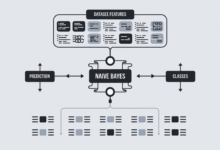
Overview of Sentiment Analysis
Sentiment analysis, a branch of natural language processing, extracts subjective information from textual data. It uses machine learning techniques to automatically understand attitudes and sentiments in text from sources like social media, online reviews, and blogs.
Companies assess customer satisfaction by analyzing opinions from reviews and social media posts. Market research firms use sentiment analysis to identify consumer trends, while governments track social discourse to address citizen concerns.
Methods of Sentiment Analysis
Sentiment analysis employs both machine learning (ML) and deep learning (DL) models. ML models include algorithms like:
- Support vector machines (SVM)
- Random forests (RF)
- Logistic regression (LR)
DL models, such as convolutional neural networks (CNN), recurrent neural networks (RNN), and transformers, process language more sophisticatedly.
Applications in Various Fields
Sentiment analysis is used in marketing, politics, healthcare, and finance. Businesses analyze customer reviews to gauge product reception, while social media monitoring tools track brand sentiment. In politics, it helps campaigners understand voter sentiment. Healthcare professionals use it to monitor patient feedback, and financial institutions analyze market sentiment for investment decisions.
Technical Components
Sentiment analysis involves:
- Data collection
- Preprocessing
- Tokenization
- Feature extraction
Machine learning models are trained on labeled datasets and evaluated using metrics such as accuracy, precision, recall, and F1 score.
Advanced Techniques
Recent advancements include hybrid models and aspect-based sentiment analysis. Attention mechanisms in transformer models improve the accuracy of analyzing longer texts.
Challenges
Sentiment analysis faces challenges in:
- Sarcasm and irony detection
- Multilingual analysis
- Domain adaptation
Future Directions
The field continues to evolve with advancements in deep learning, promising improved accuracy and broader applications across multiple languages and domains.
Deep Learning Techniques for Sentiment Analysis
Long Short-Term Memory (LSTM) networks excel at handling sequential data in sentiment analysis. They maintain information over extended sequences, making them effective for understanding sentiment within the context of entire sentences or paragraphs.
Gated Recurrent Units (GRUs) are similar to LSTMs but have a streamlined architecture. They balance simplicity and performance, making them suitable for various NLP applications, including emotion detection in customer service interactions.
Convolutional Neural Networks (CNNs) capture local features and patterns in text, such as specific phrases or n-grams that might carry sentiment. They are often used in conjunction with LSTMs or GRUs to capture both local and sequential patterns in data.
Transformer models, like BERT (Bidirectional Encoder Representations from Transformers), use self-attention mechanisms to capture contextual relationships between words. BERT considers the context from both directions around a word, making it effective for tasks requiring nuanced understanding of sentiment.
"The advent of transformer models like BERT has revolutionized sentiment analysis, allowing for more accurate and context-aware predictions."1
These deep learning techniques find practical application in diverse areas, such as:
- Real-time sentiment analysis tools
- Social media monitoring systems
- Comprehensive market analysis tools
Preprocessing Text Data for Sentiment Analysis
Preprocessing text data is crucial for sentiment analysis, involving several key techniques:
- Tokenization: Breaking down text into individual words or terms.
- Stop word removal: Eliminating common words that do not carry significant meaning.
- Stemming: Reducing words to their base or root form.
- Lemmatization: Reducing words to their base or dictionary form, maintaining semantic meaning.
- Text vectorization: Transforming text data into numerical representations.
Text vectorization methods include:
- Term Frequency-Inverse Document Frequency (TF-IDF)
- Word embeddings (Word2Vec, GloVe)
- Contextual embeddings from transformer models (BERT)
These preprocessing steps ensure that machine learning models can effectively interpret and learn from the data, leading to better performance in sentiment analysis. Proper preprocessing can significantly enhance the accuracy of sentiment analysis models, sometimes improving performance by up to 20%.2
Building and Training Sentiment Analysis Models
To construct and train deep learning models for sentiment analysis, selecting the appropriate model architecture is crucial. This section provides a guide on creating these models using TensorFlow and Keras, covering model selection, training, and evaluation processes.
We'll use the IMDB movie reviews dataset for binary sentiment classification tasks.
First, import the necessary libraries and load the dataset:
import tensorflow as tf
from tensorflow.keras.preprocessing.text import Tokenizer
from tensorflow.keras.preprocessing.sequence import pad_sequences
from tensorflow.keras.models import Sequential
from tensorflow.keras.layers import Embedding, LSTM, Dense, Dropout, Bidirectional
from tensorflow.keras.datasets import imdb
# Load the dataset
vocab_size = 10000
max_length = 120
trunc_type = 'post'
padding_type = 'post'
oov_tok = ""
(train_data, train_labels), (test_data, test_labels) = imdb.load_data(num_words=vocab_size)
Next, preprocess the data by padding/truncating the sequences:
# Pad sequences
train_data = pad_sequences(train_data, maxlen=max_length, padding=padding_type, truncating=trunc_type)
test_data = pad_sequences(test_data, maxlen=max_length, padding=padding_type, truncating=trunc_type)
Build the model:
model = Sequential()
# Embedding layer
model.add(Embedding(vocab_size, 64, input_length=max_length))
# LSTM layer
model.add(Bidirectional(LSTM(64, return_sequences=True)))
model.add(Dropout(0.5))
model.add(Bidirectional(LSTM(32)))
model.add(Dropout(0.5))
# Dense layer
model.add(Dense(24, activation='relu'))
model.add(Dense(1, activation='sigmoid'))
model.compile(loss='binary_crossentropy', optimizer='adam', metrics=['accuracy'])
print(model.summary())
Train the model:
# Training the model
num_epochs = 10
history = model.fit(train_data, train_labels, epochs=num_epochs, validation_data=(test_data, test_labels), verbose=2)
For evaluation, check the model's performance:
import matplotlib.pyplot as plt
def plot_graphs(history, metric):
plt.plot(history.history[metric])
plt.plot(history.history['val_' + metric])
plt.xlabel("Epochs")
plt.ylabel(metric)
plt.legend([metric, 'val_' + metric])
plt.show()
# Plot training and validation accuracy and loss
plot_graphs(history, "accuracy")
plot_graphs(history, "loss")
Model Selection and Fine-Tuning
Selecting the right model architecture, hyperparameters, and training settings is essential for optimal performance. Common considerations include:
- Model Architecture: Different scenarios may benefit from various deep learning structures like CNNs, RNNs, LSTMs, GRUs, or Transformers.
- Hyperparameters: Adjusting parameters such as learning rate, dropout rate, number of layers, and units.
- Regularization Techniques: Methods such as dropout to prevent overfitting and improve model generalization.
Advanced Techniques
Using pre-trained models like BERT can improve performance. Fine-tuning BERT for sentiment analysis involves:
from transformers import BertTokenizer, TFBertForSequenceClassification
model_name = "bert-base-uncased"
tokenizer = BertTokenizer.from_pretrained(model_name)
bert_model = TFBertForSequenceClassification.from_pretrained(model_name, num_labels=2)
# Tokenizing the dataset
encoding = tokenizer(["I love this movie!", "I hate this movie!"], return_tensors='tf', padding=True, truncation=True, max_length=128)
input_ids, attention_mask = encoding['input_ids'], encoding['attention_mask']
dataset = tf.data.Dataset.from_tensor_slices((input_ids, attention_mask))
# Compiling and training the BERT model
bert_model.compile(optimizer=tf.keras.optimizers.Adam(learning_rate=2e-5), loss=tf.keras.losses.SparseCategoricalCrossentropy(from_logits=True), metrics=["accuracy"])
bert_model.fit(dataset.batch(2), epochs=2)
Case Studies and Applications
Let's examine real-world applications of sentiment analysis using deep learning across various industries.
Financial Sector
In the financial sector, sentiment analysis is used for predicting market movements and informing investment strategies. Hedge funds and financial analysts use sentiment analysis on news articles, social media posts, and financial reports to assess market sentiment and predict stock price fluctuations. By using deep learning models such as LSTM and BERT, financial analysts can process large amounts of text data, identifying sentiments that impact market trends.1
Healthcare
In healthcare, sentiment analysis is used for improving patient care and experience. Hospitals and healthcare providers analyze patient feedback and reviews to identify areas for improvement. For example, a healthcare provider examined patient reviews using a deep learning model pre-trained on healthcare-specific embeddings. The analysis revealed key issues in patient experience, such as:
- Long waiting times
- Communication issues with staff
Additionally, sentiment analysis of social media posts about health services during the COVID-19 pandemic enabled public health officials to track public sentiment regarding vaccination and quarantine measures.2
Retail Industry
The retail industry, particularly e-commerce, uses sentiment analysis to examine customer reviews, extracting insights about product performance and customer preferences. Retailers can identify common complaints about a product, allowing them to address quality issues proactively. Deep learning models like CNNs and bi-directional LSTMs are effective in capturing the subtleties of customer reviews, helping retailers understand customer sentiments and modify their strategies accordingly.
Social Media Monitoring
In social media monitoring, sentiment analysis helps brands manage their online reputation. Brands employ deep learning-based sentiment analysis to monitor brand mentions and user-generated content, identifying positive and negative sentiments in real-time. This proactive approach to managing brand reputation ensures that companies can address negative sentiments promptly and reinforce positive engagement with their audience.
Political Campaigns
Political campaigns use sentiment analysis to understand voter sentiment and refine their messaging. During election periods, campaign teams analyze social media discussions and news articles to gauge public opinion on various issues. The insights gained help campaign teams understand voter concerns, adjust their messages, and focus on key issues that resonate with their target demographics.3
Entertainment Industry
In the entertainment industry, sentiment analysis is used to predict the success of movies, TV shows, and other media content. Streaming services analyze user reviews and social media discussions to determine the potential success of their content. This data-driven approach informs their content creation and acquisition strategies, ensuring they produce and acquire content that aligns with viewer interests.
Customer Service
Customer service departments use sentiment analysis to monitor and improve customer interactions. AI-driven sentiment analysis tools analyze customer service transcripts, emails, and chat logs to identify issues in service delivery. The insights gained help companies improve their customer service protocols and enhance overall customer satisfaction.
These applications demonstrate that sentiment analysis is a valuable tool that drives tangible business outcomes across various sectors.
Sentiment analysis is revolutionizing how businesses and policymakers understand and respond to public opinion. By using advanced techniques in natural language processing, we can gain deeper insights into customer feedback, market trends, and social discourse.
AI-powered content writer Writio creates high-quality articles for websites and blogs. This article was written by Writio.








